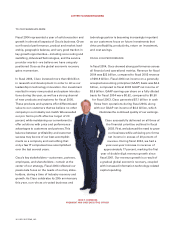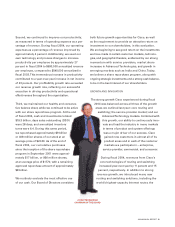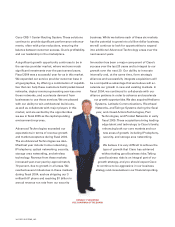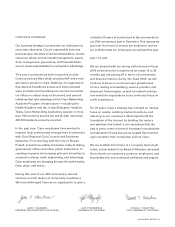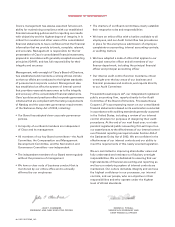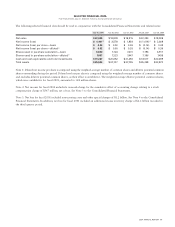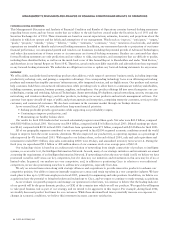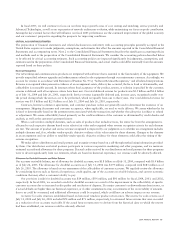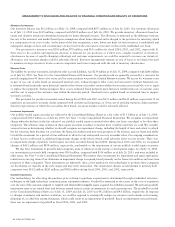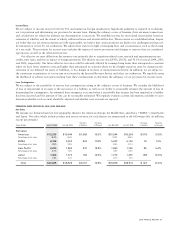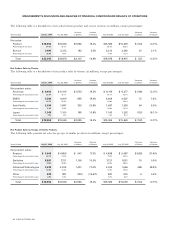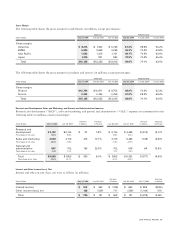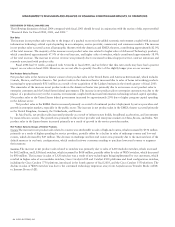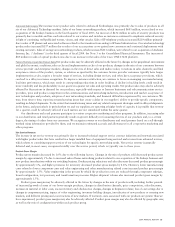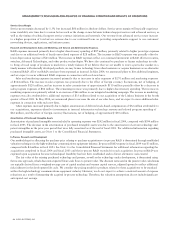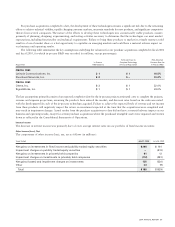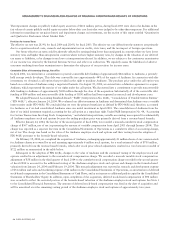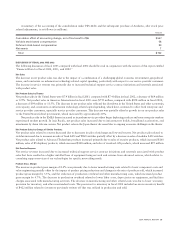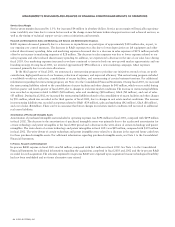Cisco 2004 Annual Report Download - page 17
Download and view the complete annual report
Please find page 17 of the 2004 Cisco annual report below. You can navigate through the pages in the report by either clicking on the pages listed below, or by using the keyword search tool below to find specific information within the annual report.
Allowance for Inventory
Our inventory balance was $1.2 billion as of July 31, 2004, compared with $873 million as of July 26, 2003. Our inventory allowances
as of July 31, 2004 were $139 million, compared with $122 million as of July 26, 2003. We provide inventory allowances based on
excess and obsolete inventories determined primarily by future demand forecasts. The allowance is measured as the difference between
the cost of the inventory and market based upon assumptions about future demand and is charged to the provision for inventory, which
is a component of our cost of sales. At the point of the loss recognition, a new, lower-cost basis for that inventory is established, and
subsequent changes in facts and circumstances do not result in the restoration or increase in that newly established cost basis.
Our provision for inventory was $205 million, $70 million, and $131 million for fiscal 2004, 2003, and 2002, respectively. If
there were to be a sudden and significant decrease in demand for our products, or if there were a higher incidence of inventory
obsolescence because of rapidly changing technology and customer requirements, we could be required to increase our inventory
allowances, and our gross margin could be adversely affected. Inventory management remains an area of focus as we balance the need
to maintain strategic inventory levels to ensure competitive lead times compared with the risk of inventory obsolescence.
Warranty Costs
The liability for product warranties, included in other accrued liabilities, was $239 million as of July 31, 2004, compared with $246 million
as of July 26, 2003. See Note 8 to the Consolidated Financial Statements. Our products sold are generally covered by a warranty for
periods ranging from 90 days to five years, and for some products we provide a limited lifetime warranty. We accrue for warranty costs
as part of our cost of sales based on associated material costs, technical support labor costs, and associated overhead. Material cost
is estimated based primarily upon historical trends in the volume of product returns within the warranty period and the cost to repair
or replace the equipment. Technical support labor cost is estimated based primarily upon historical trends in the rate of customer cases
and the cost to support the customer cases within the warranty period. Overhead cost is applied based on estimated time to support
warranty activities.
The provision for product warranties issued during fiscal 2004 and 2003 was $333 million and $342 million, respectively. If we
experience an increase in warranty claims compared with our historical experience, or if the cost of servicing warranty claims is greater
than the expectations on which the accrual has been based, our gross margin could be adversely affected.
Investment Impairments
Our publicly traded equity securities are reflected in the Consolidated Balance Sheets at a fair value of $1.1 billion as of July 31, 2004,
compared with $745 million as of July 26, 2003. See Note 7 to the Consolidated Financial Statements. We recognize an impairment
charge when the declines in the fair values of our publicly traded equity securities below their cost basis are judged to be other-than-
temporary. The ultimate value realized on these equity securities is subject to market price volatility until they are sold. We consider
various factors in determining whether we should recognize an impairment charge, including the length of time and extent to which
the fair value has been less than our cost basis, the financial condition and near-term prospects of the investee, and our intent and ability
to hold the investment for a period of time sufficient to allow for any anticipated recovery in market value. Our ongoing consideration
of these factors could result in additional impairment charges in the future, which could adversely affect our net income. There was
no impairment charge of publicly traded equity securities recorded during fiscal 2004. During fiscal 2003 and 2002, we recognized
charges of $412 million and $858 million, respectively, attributable to the impairment of certain publicly traded equity securities.
We also have investments in privately held companies, some of which are in the startup or development stages. As of July 31, 2004,
our investments in privately held companies were $354 million, compared with $516 million as of July 26, 2003, and were included in
other assets. See Note 5 to the Consolidated Financial Statements. We monitor these investments for impairment and make appropriate
reductions in carrying values if we determine an impairment charge is required, based primarily on the financial condition and near-term
prospects of these companies. These investments are inherently risky, as the markets for the technologies or products these companies
are developing are typically in the early stages and may never materialize. Our impairment charges on investments in privately held
companies were $112 million, $281 million, and $420 million during fiscal 2004, 2003, and 2002, respectively.
Goodwill Impairments
Our methodology for allocating the purchase price relating to purchase acquisitions is determined through established valuation
techniques in the high-technology communications equipment industry. Goodwill is measured as the excess of the cost of acquisition
over the sum of the amounts assigned to tangible and identifiable intangible assets acquired less liabilities assumed. We perform goodwill
impairment tests on an annual basis and between annual tests in certain circumstances for each reporting unit. The goodwill recorded
in the Consolidated Balance Sheets as of July 31, 2004 and July 26, 2003 was $4.2 billion and $4.0 billion, respectively. In response
to changes in industry and market conditions, we could be required to strategically realign our resources and consider restructuring,
disposing of, or otherwise exiting businesses, which could result in an impairment of goodwill. Based on impairment tests performed,
there was no impairment of goodwill in fiscal 2004, 2003, and 2002.
20 CISCO SYSTEMS, INC.
MANAGEMENT’S DISCUSSION AND ANALYSIS OF FINANCIAL CONDITION AND RESULTS OF OPERATIONS




